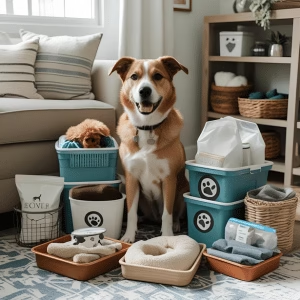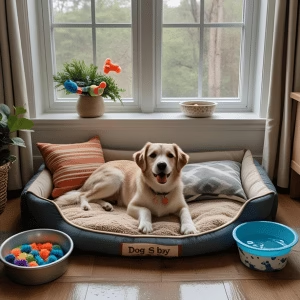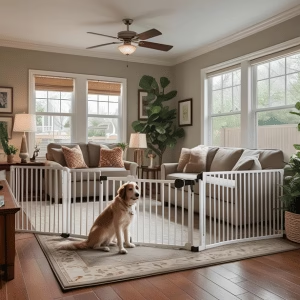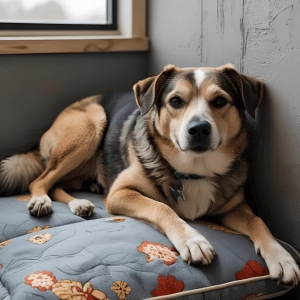So, you’ve decided to open your heart and home to a rescue dog, that’s absolutely amazing!
But here’s the thing about bringing home a rescue pup. Unlike getting a puppy from a breeder, you’re welcoming a dog with a story. Maybe they’ve been through tough times, lived in multiple homes, or spent months in a shelter environment.
The good news? When you prepare your home for a rescue dog properly, you’re setting both of you up for success from day one.
Think about it this way, your new furry friend is about to experience another major life change. Everything will be new: new smells, new sounds, new people, new rules. By creating the right environment before they arrive, you’re giving them the gift of predictability and safety in an otherwise uncertain time.
And honestly? A well-prepared home makes your life easier too. No scrambling for supplies at 9 PM when you realize you forgot something important. No emergency runs to the pet store because your new dog just destroyed your favorite shoes.
Let’s dive into exactly how to create the perfect welcome-home experience for your rescue dog.
In case you still have questions about the adoption process, check out our Complete Dog Adoption Guide, I guarantee that all your questions will be answered.
Why Preparation Actually Matters for Rescue Dogs
Here’s something most people don’t realize, rescue dogs often need more preparation than puppies or dogs from breeders.
These amazing animals have typically experienced significant changes, sometimes trauma, and they’re often hypervigilant about their environment. When everything in their new home is already set up and ready, it reduces their stress levels dramatically.
Research from animal behaviorists shows that dogs with consistent, prepared environments adapt faster and show fewer anxiety-related behaviors. For rescue dogs specifically, this preparation can mean the difference between a smooth transition and weeks of behavioral challenges.
Plus, many rescue dogs come with unknown histories. You might not know if they’re house-trained, what they’re afraid of, or what might trigger them. Being over-prepared gives you flexibility to adapt as you learn about your new companion’s needs.
Essential Supplies: Your Rescue Dog Shopping List
Before we talk about setting up spaces, let’s make sure you’ve got everything you need. Nothing’s worse than realizing you’re missing something crucial when your new dog is already home.
The Non-Negotiables:
- Food and water bowls (stainless steel or ceramic work best)
- High-quality dog food (ask the shelter what they’ve been eating)
- Collar with ID tag (get this engraved with your info before pickup day)
- 6-foot leash (avoid retractable ones initially)
- Comfortable dog bed (maybe two – one for their main area, one for your bedroom)
- Crate or designated safe space (size appropriate for your dog)
- Variety of toys (chew toys, comfort toys, puzzle toys)
- Cleaning supplies (enzyme cleaners for accidents)
- Poop bags (lots of them!)
- Treats for training (small, high-value rewards)
The Nice-to-Haves:
- Baby gates for managing access to certain areas
- Puzzle feeders to make mealtime more engaging
- Calming aids like pheromone diffusers (ask your vet first)
- Grooming supplies (brush, nail clippers, dog shampoo)
Pro tip: Buy a small bag of the food your dog has been eating at the shelter, even if you plan to switch later. Sudden diet changes can cause stomach upset, and that’s the last thing you want during their first week home.
Creating Safe Spaces: The Foundation of Success
Your rescue dog needs to know they have a place that’s entirely theirs – somewhere they can retreat when feeling overwhelmed.
Setting Up Their Primary Space:
Choose a quiet area away from high-traffic zones. This might be a corner of your living room, a spare bedroom, or even a section of your kitchen. The key is consistency – this will be their home base for the first few weeks.
What Goes in Their Space:
- Their bed or crate
- Food and water bowls
- A few favorite toys
- Something with your scent (an old t-shirt works perfectly)
The Crate Question:
Not every dog needs a crate, but for many rescue dogs, it becomes their sanctuary. If you choose to use one, make it positive from day one. Feed them in there, give special treats, never use it for punishment. Think of it as their personal bedroom, not a jail cell.
For dogs who’ve never been crated, start slowly. Leave the door open, toss treats inside, let them explore at their own pace.
Our article “Perfect Bedtime Routine for Your Dog” provide you with 7 steps to establish a solid dog bedtime routine.
Dog-Proofing: Protecting Your Home and Your Dog
Time for some real talk, rescue dogs can be unpredictable in their first few weeks. Even the most well-behaved shelter dog might act differently in a new environment.
Room-by-Room Safety Check:
Kitchen:
- Secure trash cans with tight lids
- Move cleaning supplies to high shelves or locked cabinets
- Check for food left on counters (some human foods are toxic to dogs)
- Tape down loose electrical cords
Living Areas:
- Remove or secure breakable items from coffee tables
- Put away shoes, socks, and small objects that could be swallowed
- Check for hanging cords from blinds or electronics
- Secure or remove houseplants (many are toxic to dogs)
Bedrooms:
- Close closet doors or secure them with baby latches
- Put away medications, jewelry, and small items
- Check under beds for forgotten snacks or small objects
Bathroom:
- Secure toilet lids (some dogs drink from toilets)
- Move toiletries and medications to high shelves
- Check for hair ties, cotton swabs, and other small items
Outdoor Areas:
Walk your entire yard or outdoor space before your dog arrives. Check for:
- Gaps in fencing where a dog could escape
- Toxic plants or mushrooms
- Sharp objects or debris
- Proper gate latches
- Adequate fence height for your dog’s size and jumping ability
Setting Up Feeding and Water Stations
Where and how you feed your rescue dog matters more than you might think.
Choosing the Right Location:
Pick a quiet spot away from foot traffic. Many rescue dogs have food anxiety or resource guarding issues, so they need to eat in peace. Avoid placing food bowls near their sleeping area, dogs prefer to keep eating and sleeping spaces separate.
The Setup:
- Use non-slip mats under bowls to prevent sliding
- Keep water available 24/7 in multiple locations
- If you have other pets, feed your new dog separately initially
- Consider elevated bowls for larger dogs or those with neck/back issues
Food Transition Strategy:
Start with whatever food the shelter was providing. If you want to switch brands, do it gradually over 7-10 days, mixing increasing amounts of the new food with decreasing amounts of the old food.
Establishing Boundaries and House Rules
Before your dog arrives, get your family on the same page about rules and expectations.
Key Decisions to Make:
- Which rooms are off-limits?
- Is the dog allowed on furniture?
- Where will they sleep at night?
- Who’s responsible for feeding, walking, and training?
- What commands will you use consistently?
Creating Physical Boundaries:
Use baby gates to block access to certain areas initially. This isn’t punishment, it’s management. As your dog settles in and learns the rules, you can gradually give them more freedom.
The Bedroom Question:
Many new rescue dog parents wonder if their dog should sleep in their bedroom. There’s no right or wrong answer, but consider starting with their own space and then deciding if you want to make changes once they’re settled.
Preparing for Common Challenges
Let’s be honest, the first few weeks with a rescue dog aren’t always smooth sailing. Being prepared for common issues helps you handle them calmly.
House Training Assumptions:
Assume your rescue dog isn’t house-trained, even if the shelter says they are. New environment + stress = accidents. Set up for success with:
- Frequent potty breaks (every 2-3 hours initially)
- Enzyme cleaners for accidents
- Consistent outdoor routine
- Patience and positive reinforcement
Separation Anxiety Prep:
Many rescue dogs struggle with being left alone. Prepare by:
- Starting with very short departures (5-10 minutes)
- Leaving special toys or treats that only come out when you leave
- Avoiding dramatic hellos and goodbyes
- Considering a pet camera to monitor their behavior
Behavioral Unknowns:
Your rescue dog might have triggers you don’t know about yet. Be prepared to:
- Supervise interactions with children and other pets
- Watch for signs of stress (panting, pacing, destructive behavior)
- Have the contact info for a positive-reinforcement trainer
- Give your dog time and space to decompress
The First 24 Hours: Setting the Tone
The moment you bring your rescue dog home sets the tone for everything that follows.
Arrival Day Strategy:
- Keep things calm and low-key
- Let them explore their designated space first
- Don’t overwhelm them with visitors or new experiences
- Stick to basic needs: food, water, potty breaks, and rest
- Resist the urge to take them on a grand tour of the neighborhood
Reading Their Signals:
Watch for signs that your dog is overwhelmed:
- Excessive panting or drooling
- Pacing or restlessness
- Hiding or trying to escape
- Refusing food or water
- Destructive behavior
If you see these signs, dial back the stimulation and give them more quiet time in their safe space.
Building Your Support Network
Don’t go it alone – having the right support network makes a huge difference.
Essential Contacts:
- Veterinarian: Schedule a meet-and-greet visit within the first week
- Positive-reinforcement trainer: Even well-behaved dogs benefit from training
- The rescue organization: They’re your best resource for breed-specific or individual dog advice
- Emergency vet clinic: Know where to go if something happens after hours
Community Resources:
Many areas have rescue dog support groups, both online and in-person. These communities are goldmines of practical advice and emotional support from people who’ve been exactly where you are.
Creating Long-Term Success
Prepare your home for a rescue dog isn’t just about the first day, it’s about setting up systems that work for months and years to come.
Routine Development:
Dogs thrive on predictability. Start establishing routines immediately:
- Consistent meal times
- Regular potty breaks
- Daily exercise schedule
- Bedtime routine
Gradual Freedom:
As your dog settles in and proves trustworthy, gradually expand their access to your home. This might take weeks or months, every dog is different.
Ongoing Assessment:
Your dog’s needs might change as they settle in. The shy, quiet dog who hid for the first week might turn into a playful, energetic companion who needs more mental stimulation. Stay flexible and adjust your setup as needed.
Remember, you’re not just preparing a house – you’re preparing a home. Your rescue dog has been through enough changes. By taking the time to prepare your home for a rescue dog properly, you’re giving them the greatest gift possible: stability, safety, and the chance to finally relax.
The effort you put in now pays dividends for years to come. Soon enough, you’ll look back on these preparation days as the foundation of an incredible friendship.
FAQ Section
Q: How long before I should bring my rescue dog home after adoption?
A: Ideally, pick up your dog when you can dedicate 2-3 days to being home with them. A weekend works well, giving you time to establish routines before returning to work.
Q: Should I let my rescue dog explore the whole house immediately?
A: No, start with one designated area and gradually expand their access as they settle in and learn house rules. Too much freedom too fast can be overwhelming.
Q: What if my rescue dog won’t eat or drink in their new home?
A: This is normal for the first 24-48 hours due to stress. Keep offering food and water in quiet locations. If they refuse food for more than 48 hours, contact your vet.
Q: How do I know if my rescue dog is settling in well?
A: Good signs include: eating regularly, sleeping peacefully, showing interest in toys or activities, and gradually becoming more relaxed around you. Full adjustment typically takes 2-3 months.
Q: Should I introduce my rescue dog to neighbors and friends right away?
A: Keep introductions minimal for the first week. Let your dog decompress and bond with your family first before adding new people to the mix.







